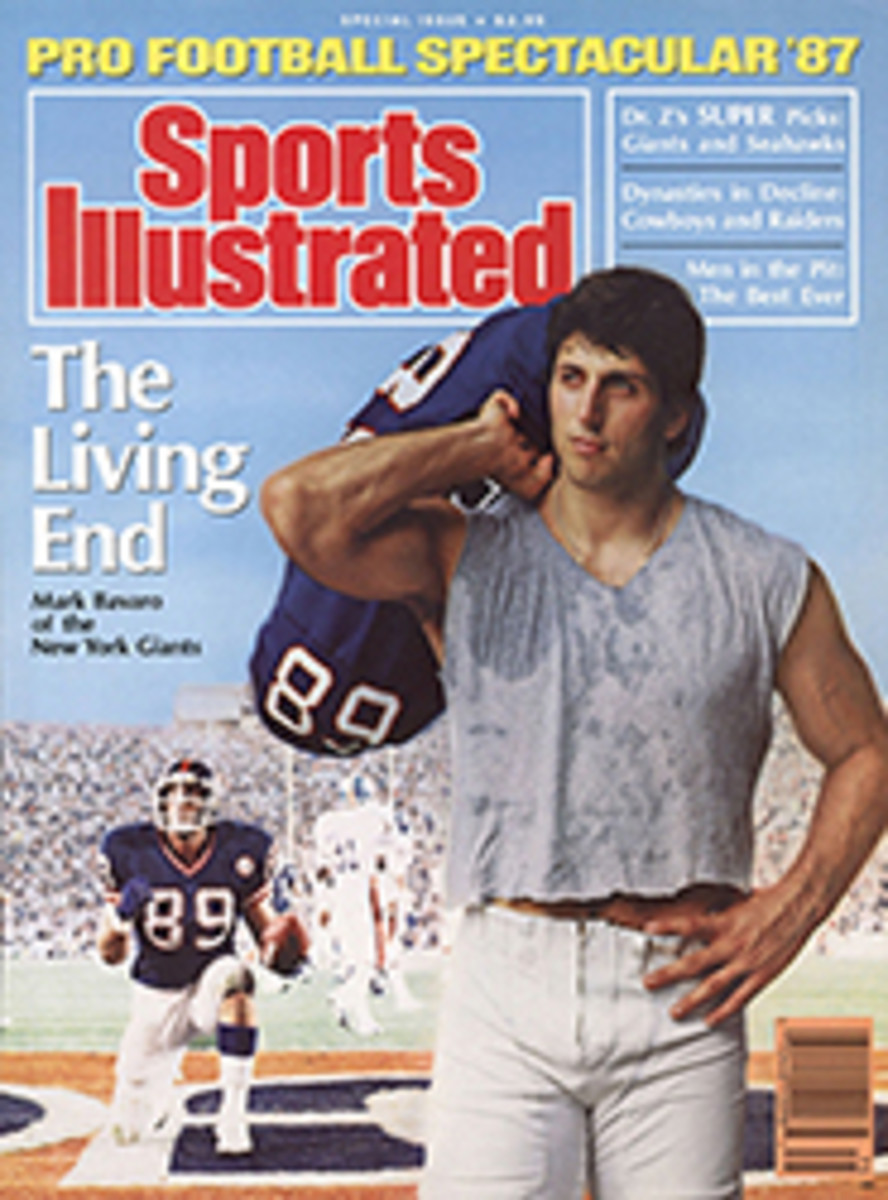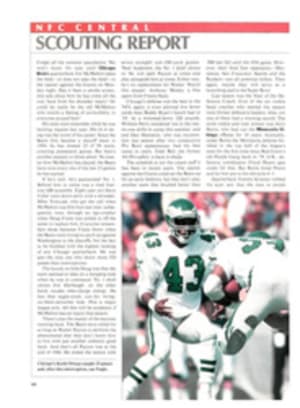
On the road again and again...
At the Pro Football hall of Fame's 10th anniversary celebration, in August 1973, charter members Ernie Nevers and Johnny Blood agreed that owners shouldn't be enshrined—at least not on the same footing as players and coaches. "But," Blood said, "if they are going to include owners, Ole Haugsrud should be here. He did more [for the NFL] than Dan Reeves, Charlie Bidwill and Lamar Hunt combined."
"Amen," said Nevers.
Just a year earlier, Haugsrud—a white-haired, gnomish man with a perpetual twinkle in his eye—had reminisced with Blood about the saga of "Ernie Nevers's Duluth Eskimos," a team whose 1926 season started in October and stretched into '27. The Eskimos played 29 games in 117 days, and 27 were on the road. They had a 6-5-2 NFL season record, and their overall record (including exhibitions) was 17-9-3. In one eight-day period they played in five different cities, from St. Louis to New York. And they did it all with a roster of just 16 players.
Nevers was the star of the Eskimos, and he earned more than $50,000 for that endless season—a base salary of $15,000 plus a share of gate receipts. The other 15 Eskimos were paid $75 per game.
Since its beginning in 1923, Duluth's NFL franchise had been a kind of cooperative. The players chipped in to pay expenses and hoped to share profits. But in 1925 the players lost up to $33 apiece per game, so they asked Haugsrud, the team's secretary/treasurer/volunteer bookkeeper, to take over as owner along with Dewey Scanlon, the player/coach. To make it legal, the two men paid a dollar for the team.
The entire NFL faced its first big threat at that time, from the American Football League, which had been organized in 1926 by C.C. (Cash and Carry) Pyle, Red Grange's manager. Grange, who had drawn big crowds on a barnstorming tour with the Chicago Bears in 1925, was the headliner for the AFL's New York Yankees. During the summer of '26, Pyle spread the word that he had also signed All-America fullback Nevers, of Stanford, the only player who could possibly draw as well as Grange.
Nevers was pitching for the St. Louis Browns at the time, and Haugsrud went to visit him. They had been high school classmates in Superior, Wis., Duluth's sister city. Nevers said he hadn't signed Pyle's contract and would rather play for the Eskimos, if Haugsrud would match Pyle's offer. Haugsrud agreed.
When Haugsrud unveiled his contract with Nevers at the NFL's scheduling meeting, league president Joe Carr rushed over to shake his hand. "Young man," Carr said with emotion, "you've just saved the National Football League."
While owners were now eager to play the Eskimos, they didn't want to take their teams to Duluth, where the cold weather and the lack of a good stadium would dilute Nevers's appeal. Scanlon and Haugsrud agreed that their team would play just two home games, and they got a stiff price in return—a guarantee of $4,000 a game, plus a cut of gate receipts over $8,000. To their regular schedule they added 10 postseason exhibitions on the West Coast, where Nevers was especially popular.
The Eskimos were the first professional team to have an out-of-town training camp, at Two Harbors, about 25 miles northeast of Duluth. They were also the first to have a distinctive emblem: A large white igloo and the team name were emblazoned on the players' coats and luggage.
As the team's manager on the four-month road trip, Haugsrud had to collect money from the home teams, arrange transportation and keep track of the players. He wasn't sure which job was the toughest.
"You couldn't collect the money in advance, because the gate receipts weren't all in," he said. "I tried to collect at halftime, because then I could threaten to pull my team off the field if I didn't get it."
One time the payment was about $70 short. "I lit out after the owner, and he ran into a ladies' room," Haugsrud recalled. "I guess he thought I wouldn't chase him in there. But I did, and I got the rest of our money."
Traveling was hectic. Nevers recalled that the Eskimos usually took two showers after a game, the first with their uniforms on. "Then we'd beat them like rugs to get some of the water out, throw them into our bags, get dressed and catch a train," he said. "Hell, most of the time we were only half-dressed when we boarded."
Then there were the antics of the players, led by the irrepressible Blood, the Vagabond Halfback, whose real name was John V. McNally Jr. He was in the second season of a 15-year NFL career that would include four championship seasons with Green Bay. Throughout his career, he was as celebrated for off-field exploits as for on-field heroics.
After two weeks of practice in Two Harbors, the Eskimos played their first home game, against Superior. They were booked into the West Duluth YMCA, but the stay was interrupted. "I got a call that night," Haugsrud recalled, "inviting me to move my players out of there. It was an innocent mistake. The boys had somehow got the impression that there was a fire, and they went out and got the fire hose and sprayed the halls and stairs. I had to move them all to the Superior YMCA."
They won that game and their next, and final, home game; then began their long journey. After a scoreless tie in Green Bay, they beat the Milwaukee Badgers and went on to Racine, Wis., where they met a speakeasy owner who was very proud of his German shepherd's sprinting ability. He boasted that the dog could run twice as fast as any football player, and he was willing to put money on it. The Eskimos scraped together $75 and nominated Blood to run.
Blood won handily. The Eskimos collected their winnings and sportingly offered the speakeasy owner a chance to get his money back on the football game. He accepted. Blood caught three touchdown passes from Nevers, Duluth beat Racine 21-0 and the Eskimos collected again.
In Chicago they suffered their first defeat, 24-6 to the Bears. After a victory over the Hammond (Ind.) Pros, they went to Cleveland, where they stayed at the Allerton Hotel, for games against Cleveland, Akron and Canton.
"It was a kind of show-business hotel," Haugsrud said. "The Marx Brothers and Mack Sennett's Bathing Beauties were there at the same time we were. The owner had a very strict rule to prevent hanky-panky: women only on even-numbered floors and men only on odd-numbered floors."
Such a silly rule was made to be broken, Blood reasoned. So he hijacked the elevator.
"John just walked into the elevator," Haugsrud said, "handed the elevator girl some change and asked her to buy him cigarettes. When she went to the cigar stand, he stole the elevator. Of course, he didn't stop it at a men's floor."
The ensuing chase would have done credit to the Marx Brothers, as Haugsrud and Nevers went running up and down stairs, trying to catch the elevator. They finally corralled Blood on a fire escape and took him to his room.
During the tour, Haugsrud wore a uniform to make it look as if the Eskimos had more players than they did, and he practiced kicking before the games. He began to think he was pretty good. "Sometime we'll let you kick the extra point, Ole," said Nevers kiddingly.
Their stretch of five games in eight days began on a Saturday in St. Louis. They were ahead of the Gunners 52-0 when Nevers waved Haugsrud in to kick a field goal. But it was a joke: The Eskimo linemen didn't block anybody, and Haugsrud was buried beneath St. Louis players. He got his revenge, though. He put his right arm in a sling and said it had been broken; he wouldn't be able to sign any paychecks until it healed. It took two weeks.
Two players were hurt in Detroit on Sunday, and the Eskimos went to New York for a Thursday game against the Giants with a squad of only 14 men. Still, the Giants barely won 14-13. On Saturday the Eskimos lost to the Frankford (Pa.) Yellowjackets, then went to Pottsville, Pa., for a Sunday game against the Maroons.
Blood, Walt Kiesling and Cobb Rooney found the local speakeasy, which was in a firehouse. Late that night, Blood and Rooney got into a friendly argument about which of them would win if they had a fight. Kiesling was to referee, and they went out into an alley. The only punch that landed was a roundhouse right from Blood that hit a brick wall. Blood's hand was broken.
Haugsrud was furious. "I fired all three of them," he said. "But that was in the morning. Well, I knew I needed them for the game, so I hired them back at noontime. Kies and Johnny are both in the Hall of Fame. I'm probably the only manager who ever fired two Hall of Famers in one day."
"When we got to the field for the game," Nevers said, "the whole damn fire department was soaking the field with water. I guess they figured the only way they could beat us was to slow us down." Nevers completed 17 consecutive passes, three of them caught one-handed by Blood, and the Eskimos won.
Haugsrud, Nevers and Blood all agreed that the next game, in Providence, was the dirtiest football game ever played. The hometown officials kept penalizing Duluth, while the Steamroller got away with everything. The culmination came about halfway through the fourth quarter, when Blood caught a pass from Nevers and was knocked out of bounds on the five-yard line. The Eskimos were promptly hit with three consecutive 15-yard penalties, moving them back to the 50.
So the Eskimos ran a most unusual play. Haugsrud described it: "Russ Method, a terrific blocker, threw a block at the referee that knocked him out. Five of our linemen put five of their linemen out of action. Jimmy Manion had this trick of jumping into the air feetfirst and kicking a guy in the teeth, and he did it to the umpire. Meanwhile, Johnny Blood just ran right over the field judge."
One official still had his whistle; he blew it and called off the game. It ended in a scoreless tie.
After the exhibition swing, the Eskimos finally got back to Duluth in early February 1927. The NFL had barely been saved. The AFL folded that year, but so did 11 of the 22 NFL franchises. For the 1927 season, Haugsrud could schedule only nine games, and he lost money. He held on to the franchise without fielding a team in 1928, then he and Scanlon sold it for $2,000. Haugsrud also got an agreement from the NFL that he would have an option on the next league franchise in Minnesota.
In 1961, the Minnesota Vikings were born. According to Haugsrud, he brought out his option and was allowed to buy 10% of the team's stock for $60,000. At his death in March 1976, his share was worth nearly $2 million, a nice return on that one-dollar investment he and Scanlon had made in 1926.
PHOTO
HALL OF FAME/NFL PHOTOS
Nevers and teammates—especially Blood—kicked up their heels on and off the field during the road trip.
Ralph Hickok has written two sports reference books and is an ad agency copy chief.

